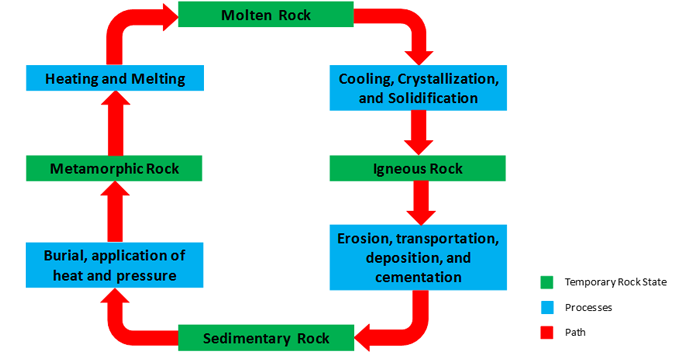There are three primary rock types present on the earth: igneous, sedimentary, and metamorphic rocks.
Igneous rocks are rocks formed by the cooling and solidification of molten rock material. As such, igneous rocks are associated with volcanology. There are two types of igneous rocks, intrusive igneous rocks and extrusive igneous rocks. Intrusive igneous rocks crystalize below the earth’s surface, allowing for slow cooling and the development of large crystal structures, while extrusive igneous rocks crystalize on the surface, resulting in rapid cooling and the development of small crystal structures. Examples of intrusive igneous rocks include diorite, granite, and peridotite; while examples of extrusive igneous rocks include basalt, pumice, and tuff.
Sedimentary rocks are rocks formed by the accumulation of sediments. There are three types of sedimentary rocks: clastic sedimentary rocks, chemical sedimentary rocks, and organic sedimentary rocks. Clastic sedimentary rocks are rocks formed by the accumulation of debris that has been mechanically broken by earth processes such as weathering and erosion. Examples of clastic sedimentary rocks include sandstones, siltstones, and shales. Chemical sedimentary rock are rocks that are formed by the precipitation of dissolved materials from high mineral content brines. Examples of chemical sedimentary rocks include rock salt, chert, some limestones, and some dolomites. Finally, organic sedimentary rocks are formed from the accumulation of organic materials (dead plants or animals). Examples of organic sedimentary rocks include coal, some limestones, and some dolomites.
Metamorphic rocks are rocks that started as some other rock type (igneous or sedimentary) but have been substantially altered from their original form by excessive heat, pressure, or exposure to high mineral content brines (or combinations of these three mechanisms). Examples of metamorphic rocks include marble, gneiss, and schist.
As stated in the introduction section of this lesson, crude oil and natural gas reside in the pore-spaces between the grains that make up the rock fabric of the reservoir rock. Consequently, the overwhelming majority of hydrocarbon reservoirs occur in sedimentary rocks where the pore-spaces in the accumulated sediments are sufficiently large to allow for the storage of crude oil and natural gas. While the pore-spaces in metamorphic and igneous rocks are too small to allow for the entry of hydrocarbon molecules, if these rock formations are mechanically fractured by tectonic forces, then the space created by the natural fractures can allow for hydrocarbon storage, and fractured reservoirs in metamorphic and igneous rocks are possible.
It should be emphasized that the formation of rock is not a static process, but is more of a dynamic, cyclical process. In other words: when a rock is formed, it is continually acted upon by earth processes and is subject to change over the geologic time-scale. This process is referred to as the Rock Cycle and is illustrated in Figure 2.03.
